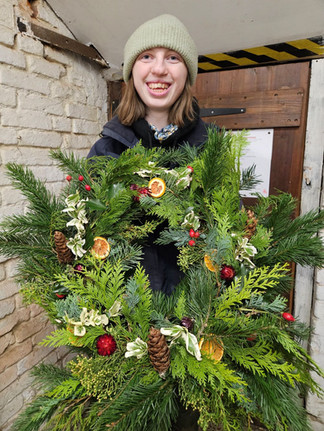With Jack Frost nipping at our noses, and gardeners dressed up like eskimos, the run up to Christmas is a busy time in Houghton’s Walled Garden. The irony is that much of the garden appears to be dormant, but December is the best month to get busy on some big jobs, says Houghton Hall's head gardener Richard Ernst.
Here, we share some behind-the-scenes photos and gardening tips from Richard and his team as they work hard to ensure everything is ready for "showtime" when we open again in spring.
The magic of mulch
Our double-width herbaceous borders, with their hot to cold colourways, are definitely one of the garden showstoppers. Visitors are astounded by their lushness and vibrancy, and ask how we achieve it. And the answer is: consistent hard work - and mulch!
In December, it's time for any perennials left to be cut down, lifted, and divided as needed. Then, the beds are ready for mulching – the application of a thick layer of organic matter across the surface. This benefits the plants by adding nutrients to the soil and keeps weeds suppressed. It also helps to reduce moisture loss in summer months.
On the subject of mulching, we receive two-and-a-half tonnes of solid digestate waste each week, which is spread through many of the borders – including asters, asparagus and roses. If you’re wondering what ‘digestate’ waste is, ours is made from composted maize which has been used in Norfolk biomass digesters. Its high nutrient content enriches the soil and in turn benefits the plants, whilst it also provides a degree of insulation from those Norfolk frosts.
The slumbering herbaceous border in December, and gardener Lindsay preparing to mulch
The hard work pays off - and delights Houghton visitors year after year
Tulips, trees, and an abundance of sweet peas!
Now that the gardens are clearer, the very last of the tulips go in. This autumn, we planted some 10,000 bulbs, including 2,500 in the new avenue behind the The Stables Café, which promises to be quite a springtime spectacle. Over in the Richard Long ‘Houghton Cross’ garden, there are a staggering 6,000 singularly planted tulips across 14 different varieties. Some of our favourites are Tulip City of Vancouver, with its pale primrose yellow flowers and golden blush, the flaming Tulip Annie Schilder and, in contrast, the dark purple Tulip Black Hero.
The team planting tulips in the Richard Long "Houghton Cross" garden - and some of last year's blooms
Houghton's trees benefit from some expert tlc too - the pleached limes in the Italian Garden have their sides and tops cut into the traditional box shape, while the London planes in the Mediterranean Garden are pollarded. This removes the upward growing branches and trains them into their distinctive umbrella poses.
Kevin pollarding in the Mediterranean Garden, and the umbrella-shaped trees in summer
There aren't many Norfolk gardens that will encourage you to pick flowers - but as a reminder of time spent at Houghton, when the sweet peas are blooming, we provide scissors so that visitors can snip some off to enjoy at home. As you can imagine, this is very popular, and so we nurture some 800 sweet pea plants. Once again, the planning starts early, and we have just sown our second batch. There is a knack to sweet pea success, however, and we have found it really helps to soak them in moist paper for a couple of days to soften the seed coat. They are then sown into root trainers to encourage a strong root system.
The holly and the ivy
As December merrily rolls on, we’re definitely counting down to Christmas – and what front door is complete without a wreath? With hundreds of acres of parkland and woodland beyond the garden wall, it’s an adventure going out to forage for materials such as ivy, holly and yew. Our spoils are then taken to the potting shed to be sorted ready to create beautiful wreaths for the Hall, plus a few commissions.
And as another year comes to a close, we like to give thanks to our garden volunteers, who have donated so much of their time, by letting them create a wreath for themselves on their last visit before Christmas.
Two of our garden volunteers, Casey and Freya, and Houghton's Estate Office door dressed for Christmas
We can't wait to welcome you back when our garden gates re-open to the public in springtime. We'll continue to share journals about the garden, the hall and other interesting sneak peaks. Sign up to our newsletters and we'll make sure you never miss one.
Wishing you a wonderful festive season - and joyous gardening.
December in the garden – a few top tips from our Norfolk garden
If you have a greenhouse, keep an eye out for pests and diseases which still flourish indoors even when it’s cold outside. In our glasshouses, we are constantly on the lookout for trouble, as we keep a number of plants available for use in the Hall at all times.
December is an excellent time to remove the fruited canes of soft fruit like autumn and summer fruiting raspberries, loganberries, and tayberries.
Any bare rooted plants like roses and raspberries should be planted. Never plant roses in the same hole as where you might have removed one from.
With high winds there is always a risk of damage. Always go through the garden after high winds looking for broken branches, trees, glass, wooden structures of trees pulled from their supportive framework.
Mice love sweet peas as much as we do - so cover the pre-soaked seeds with a small, meshed wire until they have germinated, or you could lose them all.

























